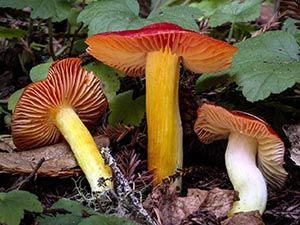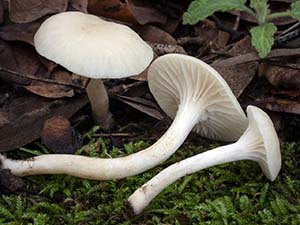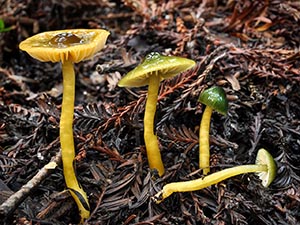On Waxcaps
One of the surprising sights in the North American forests are waxcap species–the colourful members of the genera Hygrocybe, Cuphophyllus, and Gliophorus. I started my mycological career in the Netherlands, where waxcaps grow in grasslands: un-fertilized, non-disturbed, non-production, so-called unimproved grasslands. That runs true for the rest of northwestern Europe; waxcaps grow in grasslands, species of the genus Hygrophorus in forests. They are a good indicator species for the grassland’s health (health in a biological diversity sense). Such grasslands have become very rare in the last century due to an overwhelming desire to fertilize these mushroom-rich grasslands and change them into uniform production units for cattle; the high levels of nitrogen deposition in general also form a severe threat to this habitat. These grasslands not only sport a fair number of Hygrocybes, but also earth tongues, Clavaria and Clavariopsis species, and Leptonias are well represented. All these species can be found here in California in the coastal redwood forests and Monterey cypress plantations in great numbers. Though waxcap species grow in the California forests, they also can be found in grasslands. One example is a species described by David Largent under the name Hygrophorus subbasidiosus: a grey-brown species that nowadays would be placed in Cuphophyllus. This was found on a shaded lawn near the biology building on the UC Berkeley campus in January, 1939. But fertilizers and constant herbicide spraying have changed the campus lawns into dark green monotonous grassmats. Now, only Panaeolus foenisecii, the haymaker’s fungus, and Bolbitius titubans (sunny-side-up) are regularly found.

As soon as waxcap rich grasslands are treated with fertilizers, herbicides, or other “cides,” and as soon as the sheep or cattle that keep the sward short are removed, waxcap species will cease to fruit. It can take years before the original richness in fruitbodies is restored. In the UK, waxcap species have become the flagship of conservation efforts for those grasslands, as they are colourful and easy to recognize as a group and hence highly charismatic.
These fungi raise some interesting questions that have puzzled scientists over the last 10 years. What do they live from? Why are they so sensitive to disturbances such as fertilizers? And how is it possible that these species are grassland species in northern Europe, and yet, do so well in woods and forests in North America?
You have to realize that scientists have not yet discovered how to grow these fungi in culture. Their spores can germinate in the lab, but only a small percentage does so, and only from a few species. Cuphophyllus virgineus spores are exceptional in that they germinate in reasonable numbers, and of all waxcaps, this species is the most tolerant to disturbances.
The Northern European grasslands are artificial habitats; they exist only because of management measures such as grazing and mowing. A grassland left alone changes rapidly into a woodland. By looking at grasslands in this way (as thwarted woodlands), forests and grasslands are no longer that different. Waxcap species can then be considered as “leftovers” from the pre-grassland forests.
Hygrophorus is a close relative of the grassland waxcap species and its lifestyle is well known. Hygrophorus species are truly ectomycorrhizal with various tree species; that is, the mushrooms get their sugars from the tree, and the fungus scavenges for nitrogen, which it will deliver to the tree. The exchange of these goodies takes place in the tree roots, with the fungus growing around and into the roots, but never penetrating into the cells. Hygrophorus hypothejus is a typical pine associate, and you will find H. roseibrunneus under oaks.
However, it is much less clear how the waxcap species get their carbon and their nitrogen. They are not ectomycorrhizal, as ectomycorrhizal hosts neither occur in these grasslands nor in the redwood forests, and they don’t form the typical ectomycorrhizal structures around the roots of trees.
The profiles of nitrogen and carbon (sugars!) uptake of waxcaps differ considerably from those of saprotrophic fungi that break down dead plant material. Waxcaps possibly get their nitrogen from humus, but their sugars come from living plants, just as ectomycorrhizal fungi do.
But which plants could those be?

Two recent studies have looked at plant roots: the roots of grass and the roots of Plantago lanceolata. To our surprise, the hyphae of waxcaps were found within these roots. So now it is thought that waxcaps get their sugars from living plants, but not from ectomycorrhizal trees. This is still a theory, as it has not been shown that sugar from the plant ends up in the mushroom.
This idea also leaves lots of room for questions, as waxcaps are found in grasslands and in woodlands. In fact, I don’t see grasses in the redwood forest that much, or under Monterey cypress. But there is always ample poison oak around; could that be the source of sugars for the waxcaps? Mosses have also been postulated as sugar providers, and that might be the case in grasslands, or in mossy eastern North American forests. But look again at the photo of the Monterey cypress waxcap to the right, where mosses are definitely absent.
One other piece of information that might be relevant is that many species in the family Hygrophoraceae are lichens, in which the fungus forms a symbiosis with green algae (this is the case for Lichenomphalia), or with cyanobacteria (tropical Dictyonema species). The algae and cyanobacteria are enslaved by the fungi to provide the sugars on which the fungus thrives. Moss-inhabiting Arrhenia species are in this same family, but also the beautiful lilac-gilled wood-inhabiting Chromosera lilacifolia which looks and behaves like a true saprotrophic fungus.
So, instead of getting clear answers on the questions about the ecology of the waxcaps, we are confronted with a plethora of nutrition modes within one natural group of fungi and more questions about the evolutionary history and the biology of these fungi than ever.

There is quite a list of articles that delve into the various aspects of the Hygrophoraceae, plus a few websites that give information. I want to point you to two papers that are relevant for aspects other than ecology: The first is on the phylogeny of the whole family (by Lodge et al., 2014). The second is a small article that studied some closely related British waxcap species in depth. These species differ in colours, but are for the rest very similar. A small part of DNA of differently coloured specimens was compared; this particular piece of DNA does not cause the different colours, and yet, there is a correlation between colour and the signature in this part of the DNA. So far two new species were described based on this study. DNA variation among different parrot mushrooms (Gliophorus psittacinus) was also detected, and this might have implications for the names we use for the western species. We have probably several species of parrots, and none the same as in Europe!
Further reading:
- Ainsworth AM, Cannon PF, Dentinger BTM. 2013. DNA barcoding and morphological studies reveal two new species of waxcap mushrooms (Hygrophoraceae) in Britain. MycoKeys 7: 45–62.
- Dal-Forno M, Lawrey JD, Sikarood M, Bhattarai S, Gillevet PM, Sulzbacher M, Lücking R. 2013. Starting from scratch: Evolution of the lichen thallus in the basidiolichen Dictyonema (Agaricales: Hygrophoraceae). Fungal Biology 117: 584–598.
- Griffith GW, Easton GL, Jones AW. 2002. Ecology and diversity of waxcap (Hygrocybe spp.) fungi. Bot. J. Scotl. 54: 7–22.
- Halbwachs H., Dentinger BTM, Detheridge AP, Karasch P, Griffith GW. 2013. Hyphae of waxcap fungi colonise plant roots. Fungal Ecology 6: 487–492.
- Lawrey JD, Lücking R, Sipman HJM, Chaves JL, Redhead SA, Bungartz F, Sikaroodi M, Gillevet PM. 2009. High concentration of basidiolichens in a single family of agaricoid mushrooms (Basidiomycota: Agaricales: Hygrophoraceae) Mycological Research 113: 1154–1171
- Lodge, DJ, et al. 2014. Molecular phylogeny, morphology, pigment chemistry and ecology in Hygrophoraceae (Agaricales). Fungal Diversity 64: 1–99. [open access]
- Seitzmann BH, Ouimette A, Mixon RL, Hobbie EA, Hibbett DS. 2011. Conservation of biotrophy in Hygrophoraceae inferred from combined stable isotope and phylogenetic analyses. Mycologia 103: 280–290.
- Tell SA, Silva-Flores P, Agerer R, Halbwachs H, Beck A, Peršoh D. Hygrocybe virginea is a systemic endophyte of Plantago lanceolata. Mycological progress DOI 10.1007/s11557-013-0928-0
- Conserving British waxcap fungi
- Waxcap Website
Else Vellinga, Ph.D., is interested in mushroom taxonomy and has been studying mushrooms in California and beyond for years. A frequent contributor to Mycena News, she is also fascinated by interactions between fungi and other organisms. In her free time she knits, and knits, and knits!

